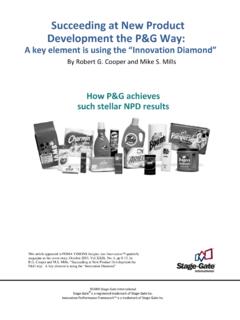Transcription of INNOVATION You Need an Innovation Strategy
1 INNOVATIONYou Need an InnovationStrategyby Gary P. PisanoFROM THE JUNE 2015 ISSUED espite massive investments of management time and money, INNOVATION remains afrustrating pursuit in many companies. INNOVATION initiatives frequently fail, andsuccessful innovators have a hard time sustaining their performance as Polaroid,Nokia, Sun Microsystems, Yahoo, Hewlett-Packard, and countless others have found. Why is itso hard to build and maintain the capacity to innovate? The reasons go much deeper than thecommonly cited cause: a failure to execute. The problem with INNOVATION improvement effortsis rooted in the lack of an INNOVATION Strategy is nothing more than a commitment to a set of coherent, mutually reinforcing policiesor behaviors aimed at achieving a specific competitive goal. Good strategies promote alignmentamong diverse groups within an organization, clarify objectives and priorities, and help focusefforts around them.
2 Companies regularly define their overall business Strategy (their scope andpositioning) and specify how various functions such as marketing, operations, finance, andR&D will support it. But during my more than two decades studying and consulting forcompanies in a broad range of industries, I have found that firms rarely articulate strategies toalign their INNOVATION efforts with their business an INNOVATION Strategy , INNOVATION improvement efforts can easily become a grab bagof much-touted best practices: dividing R&D into decentralized autonomous teams, spawninginternal entrepreneurial ventures, setting up corporate venture-capital arms, pursuing externalalliances, embracing open INNOVATION and crowdsourcing, collaborating with customers, andimplementing rapid prototyping, to name just a few. There is nothing wrong with any of thosepractices per se. The problem is that an organization s capacity for INNOVATION stems from aninnovation system: a coherent set of interdependent processes and structures that dictates howthe company searches for novel problems and solutions, synthesizes ideas into a businessconcept and product designs, and selects which projects get funded.
3 Individual best practicesinvolve trade-offs. And adopting a specific practice generally requires a host of complementarychanges to the rest of the organization s INNOVATION system. A company without an innovationstrategy won t be able to make trade-off decisions and choose all the elements of the someone else s system is not the is no one system that fits all companiesequally well or works under all is nothing wrong, of course, with learningfrom others, but it is a mistake to believe thatwhat works for, say, Apple (today s favoriteinnovator) is going to work for yourorganization. An explicit INNOVATION strategyhelps you design a system to match yourspecific competitive , without an INNOVATION Strategy , different parts of an organization can easily wind uppursuing conflicting priorities even if there s a clear business Strategy . Sales representativeshear daily about the pressing needs of the biggest customers.
4 Marketing may see opportunitiesto leverage the brand through complementary products or to expand market share through newdistribution channels. Business unit heads are focused on their target markets and theirparticular P&L pressures. R&D scientists and engineers tend to see opportunities in newtechnologies. Diverse perspectives are critical to successful INNOVATION . But without a Strategy tointegrate and align those perspectives around common priorities, the power of diversity isblunted or, worse, becomes good example of how a tight connectionbetween business Strategy and INNOVATION candrive long-term INNOVATION leadership is foundin Corning, a leading manufacturer of specialtycomponents used in electronic displays,telecommunications systems, environmentalproducts, and life sciences instruments.(Disclosure: I have consulted for Corning, butthe information in this article comes from the2008 HBS case study Corning: 156 Years ofInnovation, by H.)
5 Kent Bowen and CourtneyPurrington.) Over its more than 160 yearsCorning has repeatedly transformed its businessand grown new markets through breakthroughinnovations. When judged against current bestpractices, Corning s approach seems out of company is one of the few with acentralized R&D laboratory (Sullivan Park, inrural upstate New York). It invests a lot in basicresearch, a practice that many companies gaveup long ago. And it invests heavily inmanufacturing technology and plants andcontinues to maintain a significantmanufacturing footprint in the United States,bucking the trend of wholesale outsourcing andoffshoring of when viewed through a strategic lens,Corning s approach to INNOVATION makes perfectsense. The company s business Strategy focuseson selling keystone components thatsignificantly improve the performance of customers complex system products. Executing thisstrategy requires Corning to be at the leading edge of glass and materials science so that it cansolve exceptionally challenging problems for customers and discover new applications for itstechnologies.
6 That requires heavy investments in long-term research. By centralizing R&D,Corning ensures that researchers from the diverse disciplinary backgrounds underlying its coretechnologies can collaborate. Sullivan Park has become a repository of accumulated expertise inthe application of materials science to industrial problems. Because novel materials oftenrequire complementary process innovations, heavy investments in manufacturing andtechnology are a must. And by keeping a domestic manufacturing footprint, the company is ableto smooth the transfer of new technologies from R&D to manufacturing and scale s Strategy is not for everyone. Long-term investments in research are risky: Thetelecommunications bust in the late 1990s devastated Corning s optical fiber business. ButCorning shows the importance of a clearly articulated INNOVATION Strategy one that s closelylinked to a company s business Strategy and core value proposition.
7 Without such a Strategy ,most initiatives aimed at boosting a firm s capacity to innovate are doomed to this and other HBR graphics in our VISUAL LIBRARY Connecting INNOVATION to StrategyAbout 10 years ago Bristol-Myers Squibb (BMS), as part of a broad strategic repositioning,decided to emphasize cancer as a key part of its pharmaceutical business. Recognizing thatbiotechnology-derived drugs such as monoclonal antibodies were likely to be a fruitful approachto combating cancer, BMS decided to shift its repertoire of technological capabilities from itstraditional organic-chemistry base toward biotechnology. The new business Strategy (emphasizing the cancer market) required a new INNOVATION Strategy (shifting technologicalcapabilities toward biologics). (I have consulted for BMS, but the information in this examplecomes from public sources.) FURTHER READINGB eyond World-Class: The NewManufacturing StrategyLike the creation of any good Strategy , the process of developing an INNOVATION Strategy shouldstart with a clear understanding and articulation of specific objectives related to helping thecompany achieve a sustainable competitive advantage.
8 This requires going beyond all-too-common generalities, such as We must innovate to grow, We innovate to create value, or We need to innovate to stay ahead of competitors. Those are not strategies. They provide nosense of the types of INNOVATION that might matter (and those that won t). Rather, a robustinnovation Strategy should answer the following questions:How will INNOVATION create value for potential customers?Unless INNOVATION induces potential customers to pay more, saves them money, or providessome larger societal benefit like improved health or cleaner water, it is not creating value. Ofcourse, INNOVATION can create value in many ways. It might make a product perform better ormake it easier or more convenient to use, more reliable, more durable, cheaper, and so what kind of value your INNOVATION will create and then sticking to that is critical,because the capabilities required for each are quite different and take time to accumulate.
9 Forinstance, Bell Labs created many diverse breakthrough innovations over a half century: thetelephone exchange switcher, the photovoltaic cell, the transistor, satellite communications,the laser, mobile telephony, and the operating system Unix, to name just a few. But research atBell Labs was guided by the Strategy of improving and developing the capabilities and reliabilityof the phone network. The solid-state research program which ultimately led to the inventionof the transistor was motivated by the need to lay the scientific foundation for developingnewer, more reliable components for the communications system. Research on satellitecommunications was motivated in part by the limited bandwidth and the reliability risks ofundersea cables. Apple consistently focuses its INNOVATION efforts on making its products easierto use than competitors and providing a seamless experience across its expanding family ofdevices and services.
10 Hence its emphasis on integrated hardware-software development,proprietary operating systems, and design makes total will the company capture a share ofthe value its innovations generate?COMPETITION MAGAZINE ARTICLE by Robert H. Hayes andGary P. PisanoCompanies need strategies for building criticalcapabilities to achieve competitive advantage. SAVE SHARE Value-creating innovations attract imitators asquickly as they attract customers. Rarely isintellectual property alone sufficient to blockthese rivals. Consider how many tabletcomputers appeared after the success of Apple siPad. As imitators enter the market, they createprice pressures that can reduce the value that the original innovator captures. Moreover, if thesuppliers, distributors, and other companies required to deliver an INNOVATION are dominantenough, they may have sufficient bargaining power to capture most of the value from aninnovation.






